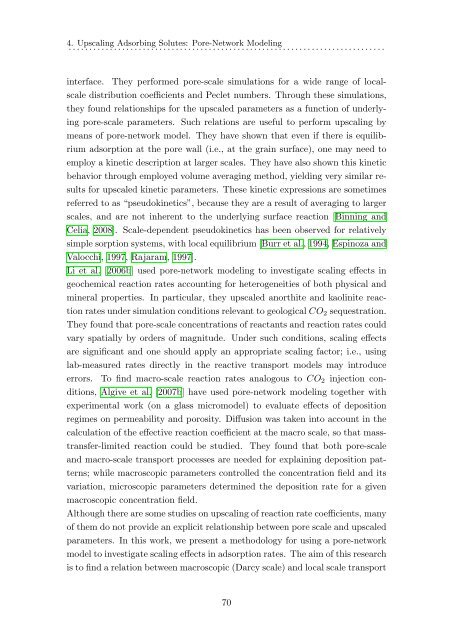download pdf version of PhD book - Universiteit Utrecht
download pdf version of PhD book - Universiteit Utrecht
download pdf version of PhD book - Universiteit Utrecht
Create successful ePaper yourself
Turn your PDF publications into a flip-book with our unique Google optimized e-Paper software.
4. Upscaling Adsorbing Solutes: Pore-Network Modeling<br />
. . . . . . . . . . . . . . . . . . . . . . . . . . . . . . . . . . . . . . . . . . . . . . . . . . . . . . . . . . . . . . . . . . . . . . . . . . . . .<br />
interface. They performed pore-scale simulations for a wide range <strong>of</strong> localscale<br />
distribution coefficients and Peclet numbers. Through these simulations,<br />
they found relationships for the upscaled parameters as a function <strong>of</strong> underlying<br />
pore-scale parameters. Such relations are useful to perform upscaling by<br />
means <strong>of</strong> pore-network model. They have shown that even if there is equilibrium<br />
adsorption at the pore wall (i.e., at the grain surface), one may need to<br />
employ a kinetic description at larger scales. They have also shown this kinetic<br />
behavior through employed volume averaging method, yielding very similar results<br />
for upscaled kinetic parameters. These kinetic expressions are sometimes<br />
referred to as “pseudokinetics”, because they are a result <strong>of</strong> averaging to larger<br />
scales, and are not inherent to the underlying surface reaction [Binning and<br />
Celia, 2008]. Scale-dependent pseudokinetics has been observed for relatively<br />
simple sorption systems, with local equilibrium [Burr et al., 1994, Espinoza and<br />
Valocchi, 1997, Rajaram, 1997].<br />
Li et al. [2006b] used pore-network modeling to investigate scaling effects in<br />
geochemical reaction rates accounting for heterogeneities <strong>of</strong> both physical and<br />
mineral properties. In particular, they upscaled anorthite and kaolinite reaction<br />
rates under simulation conditions relevant to geological CO 2 sequestration.<br />
They found that pore-scale concentrations <strong>of</strong> reactants and reaction rates could<br />
vary spatially by orders <strong>of</strong> magnitude. Under such conditions, scaling effects<br />
are significant and one should apply an appropriate scaling factor; i.e., using<br />
lab-measured rates directly in the reactive transport models may introduce<br />
errors. To find macro-scale reaction rates analogous to CO 2 injection conditions,<br />
Algive et al. [2007b] have used pore-network modeling together with<br />
experimental work (on a glass micromodel) to evaluate effects <strong>of</strong> deposition<br />
regimes on permeability and porosity. Diffusion was taken into account in the<br />
calculation <strong>of</strong> the effective reaction coefficient at the macro scale, so that masstransfer-limited<br />
reaction could be studied. They found that both pore-scale<br />
and macro-scale transport processes are needed for explaining deposition patterns;<br />
while macroscopic parameters controlled the concentration field and its<br />
variation, microscopic parameters determined the deposition rate for a given<br />
macroscopic concentration field.<br />
Although there are some studies on upscaling <strong>of</strong> reaction rate coefficients, many<br />
<strong>of</strong> them do not provide an explicit relationship between pore scale and upscaled<br />
parameters. In this work, we present a methodology for using a pore-network<br />
model to investigate scaling effects in adsorption rates. The aim <strong>of</strong> this research<br />
is to find a relation between macroscopic (Darcy scale) and local scale transport<br />
70

















